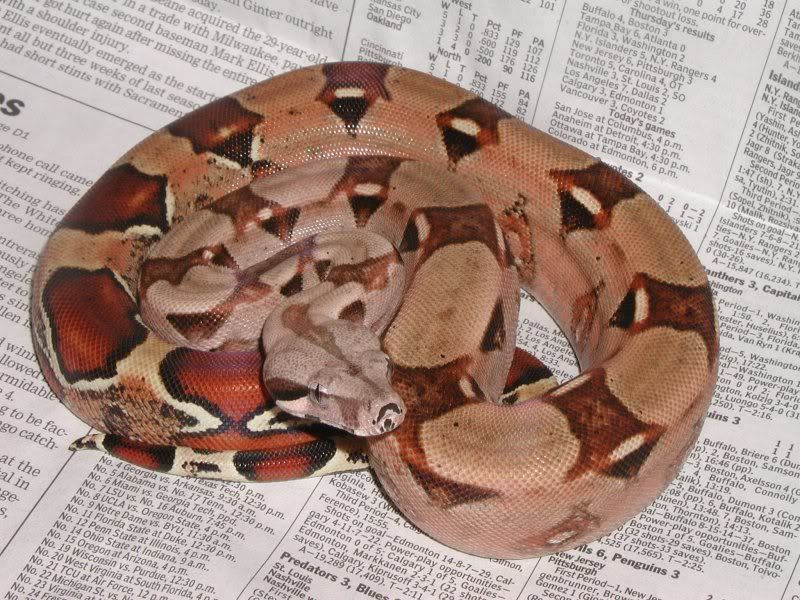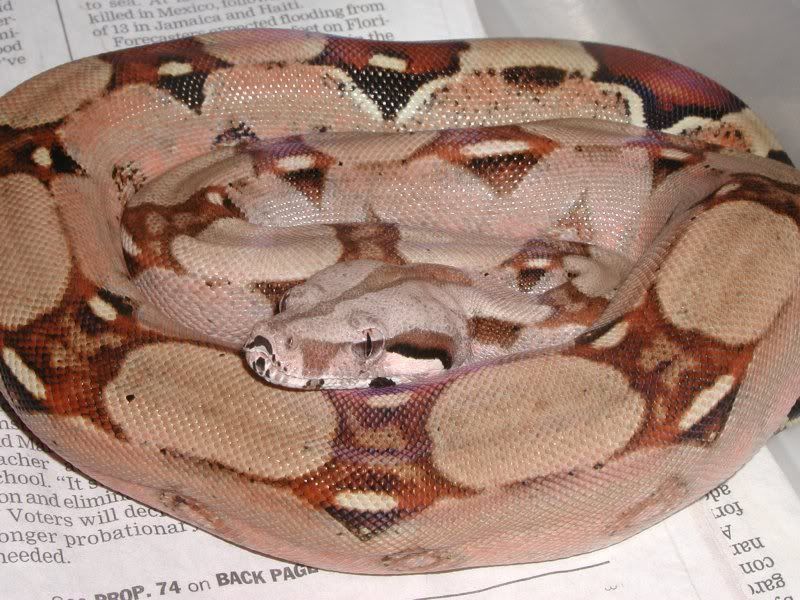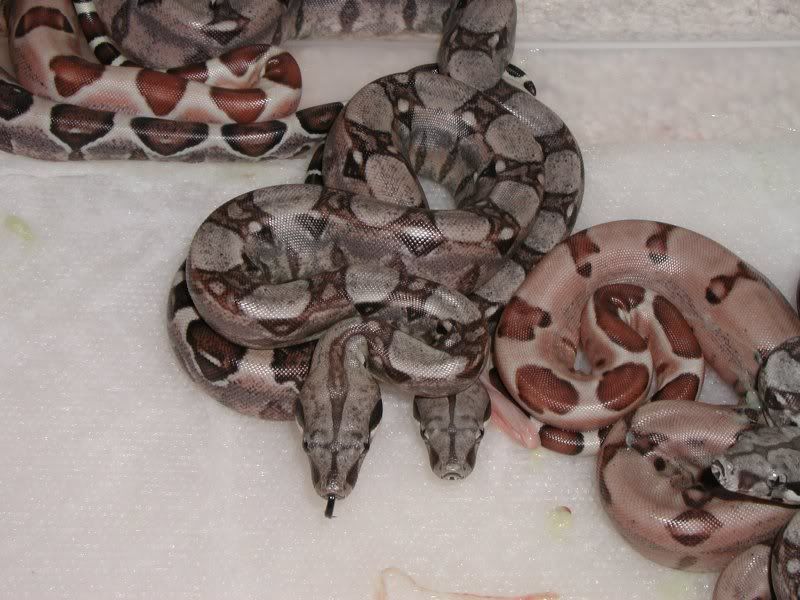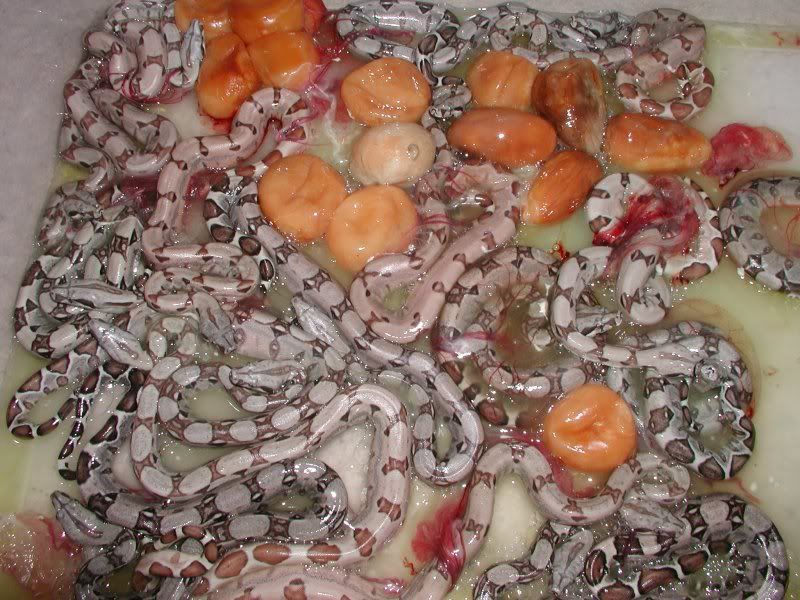Posted by:
JohnLokken
at Wed Mar 15 23:16:38 2006 [ Email Message ] [ Show All Posts by JohnLokken ]
I have only heard of one person in the boa world (I could be wrong) that has claimed his pastels are co-dominant. We have the same pastel bloodline from the originator. I will still not go as far as saying that a pastel is co-dominant. I personally think that it is missleading.
Here's my biggest reason. The originator (Jeff Ronne) of the boa "pastel" name has dubbed a pastel polygenetic. Meaning the more generations of pastels you breed the better the animals and future animals look. This also means that you could take a nice pastel looking boa that is not associated by any known bloodline and breed it with another pastel that is not associated by a known bloodline and "create" a new pastel bloodline. This breeding process takes years and really knowing what a pastel is. Reduction of black.........Not color.
So this, in my opinion, is the official description of a pastel from the originator. It's polygenetic.
Now, to muddy the waters a little. LOL!
The litter I was lucky enough to produce was a Ronne Pastel female bred with a pastel anery male. The outcome "followed" the dominant trait somewhat. There were some amazing pastels in the litter. There were some nice pastels from the litter. There were a few "low appearing" pastels in the litter. Out of the whole litter of 21 babies.......I would only really call one animal a normal.
I also just had a litter from the same Ronne pastel momma who was bred with a ghost male. The pastel gene has really affected the quality of the hypos in my opinion. (Can you tell I'm a pround new daddy? LOL!) What is going to be really interesting for me now is to see how the non hypo animals develope. There are already quite a few babies I would call a pastel. But, it's still kind of early to tell. They were just born on the 13th and I'm really trying hard not to bug them. 
Like you stated....What adds even more confusion to the "pastel debate" is that it means different things to different animals. (ie ball world and the boa world.)
Another thing to note is that some people will call a boa that is a pastel a "good looking normal" and that's it. Generally I get my feathers ruffled a little.....Or, my panties in a bunch....I can't remember which.......When I hear this.
There are two sides to this coin.
1)There are a lot of breeders that work hard at developing great pastel animals. They take pride in their animals and bloodlines. They take the time to find the right animals and breed them accordingly.
2)The other side is people either don't know what a pastel is or they attach the name to their animal in hopes to sell it for more money.
Obviously, things are not always this black and white. But, I'm beginning to write a novel here. LOL!
I always state that the pastel boa is a buyer beware animal. I think that if you are getting into pastel you should do a few things before you buy one.
1)Understand what the name identifies as far as traits and characteristics.
2)Look around and see different pastels. Find out what a nice one looks like and what a "beginner" pastel looks like.
The first pastel I bought was a pretty bad one. If I were to see it now I wouldn't spend the money on it. Then you see others and go WOW!! I have to own that!!!
3)Ask the seller about their bloodline.
Here are a couple of pics of my pastel litter from 2004. This was from a pastel x pastel


Here are a couple of pics from my 2006 litter. Mind you, there are pastel hypos in there. This was from a pastel x ghost



Here's a link to Ronne's pastel description.
http://www.boaconstrictor.net/forums/showthread.php?t=386
Here is a write up I did sometime ago.
Here is my half a cup of coffee/trying to get the kids ready in the morning pastel definition .
For me, since the Pastel term was coined by Ronne I have stuck to what his definition is. It is an animal that is line bred, which exhibits an overall reduction of black. Breeding two animals, which have this look, should result in some offspring exhibiting a more noticeable reduction of black. Pastel is almost a misnomer in my eye. It has nothing to do with color at all. This is a natural hang up due to the name. It is almost misleading. (Which I am sure it was not meant to be.)
It is a line driven morph plain and simple. THIS IS WHERE the labeling questions begin. Like you, I have also seen many, many animals being sold as pastels that I would never buy. Like you said, they look just like normals. This morph is a VERY buyer beware animal in my opinion. You have to know what a Pastel really is before you can buy one. It really is a sad truth. People will ride on the coat tails of know names to sell their animals. American Jungles, almost Motleys, Arabasqueish, and lets not forget Pastel. I have been around for quite some time. Luckily, I pretty much know a fake when I see one. (A side note Since Jungles have been posted here so much it is my prediction we will see a lot more Jungles in the classifieds which will only end up being aberrant boas.)
Sorry, I am digressing. Here is where the real confusion lies .
Since the pastel is a line driven animal all you need to start off with are a couple of boas that have a noticeable reduction of black. The some of the babies would/could be first generation pastels. Since it is a line driven animal. It does not have to come from the founderís name only. (Even though some of them have. Ex. EBV reds) So, this is where the different pastel line names come from. Davey pastel is a great example of this. His bloodline has no association with Ronnes that I know of. But, they are an awesome example of the beauty of a pastel. Seeing some of Larry Keller's animals posted on here are a great example of a pastel. (But, I think he just labels them as nice normals only.) So, people use the description of the animal by try and show that this is their line.
Genetics????????//
Again, I will wait for the founder of the line to officially say how he thinks the genetics are. I can however share my experience with breeding pastels.
I had a Ronne Pastel bred to a male Church Pastel Anery. (The Ronne is a know line of pastels. The anery was always/still is a very light animal. Still a reduction of black on him) Breeding these two animals together brought about 21 babies. Only one looked like a normal boa. The rest exhibited the pastel trait from their parents. There was obviously a varying degree as well. In my opinion, there are lesser pastels and high-end pastels. All are differentiated by their overall reduction of black. Color was a nice byproduct. But, has nothing to do with being a pastel. It's just icing on the cake.
Here are things I look for in a pastel.
And, for the sake of the examle...I'm only talking about normals . No Anerys....Etc.
1) Overall look. Speckling/black??? How light is the animal? How much contrast does the animal have?
2) Side medallions. Are they faint....Or, dark??? Do they have low/medium/high degree of black within it?
3)The belly. Is the speckling/black? Again, low/medium/high.
4)The side of the tail. Where the tail bands are. Is the speckling/black? Again, low/medium/high.
5)I erased five.
6)Saddles. Are they tan. How much black is there? low/medium/high.
7)I will even look at the moustache . Is it all there? Or, does it appear to be smaller than normal. We've all heard this technique talked about with hypos.
8)Color. Now this has nothing to do with an animal being a pastel...But, I want it all
So it really is an overall reduction of black. And, there are many variables to it. It can't be helped unfortunately. So, I look at all these things and then think to myself....This animal will darken with age.....Will this be a light or dark adult?
Hope my post makes sense. It's the ramblings of a madman.
OK, I'm spent. I'm going to bed!! 
Take care,
John
-----
"To be the best..........You must lose your mind."
[ Show Entire Thread ]
|



